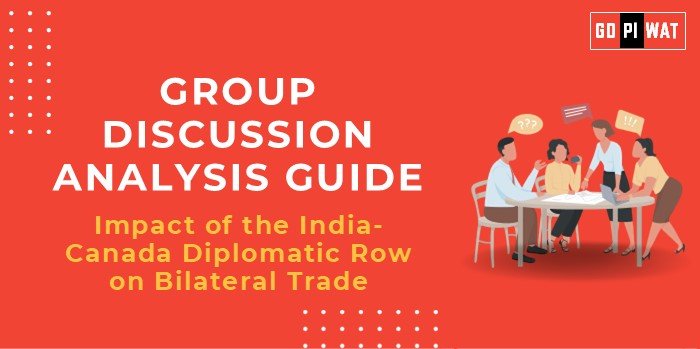📋 Impact of the India-Canada Diplomatic Row on Bilateral Trade
🌐 Introduction to the Impact
The diplomatic tensions between India and Canada have recently escalated, affecting not only political relations but also their substantial economic ties. Given their history of cooperation in trade, technology, and investment, the impact on bilateral trade deserves close scrutiny, especially for global economic implications and B-school discussions.
The row originated from political disagreements, including issues surrounding diaspora politics, allegations of interference, and security concerns, which have strained historically robust diplomatic channels. This dispute has affected sectors such as agriculture, technology, education, and investments, with potential long-term consequences on economic collaboration.
📊 Quick Facts and Key Statistics
• Bilateral Trade Volume: In the fiscal year 2023-24, India and Canada recorded merchandise trade worth $8.4 billion, a slight increase from $8.3 billion in 2022-23.
• Indian Diaspora in Canada: Over 1.4 million people of Indian origin reside in Canada, strengthening economic and cultural connections.
• Foreign Direct Investment (FDI): Canadian investments in India have been significant, with substantial inflows in sectors like infrastructure and technology.
• Key Trade Sectors: Agriculture, information technology services, and education are pivotal areas of economic collaboration between the two countries.
🤝 Stakeholders and Their Roles
- 🏛️ Government Agencies: The Ministries of Foreign Affairs and Trade in both countries are crucial in navigating diplomatic challenges and facilitating trade negotiations.
- 🏢 Private Companies: Businesses in sectors such as agriculture, technology, and education are directly affected by the diplomatic climate, influencing their operations and investments.
- 🌍 Citizens and Diaspora Communities: Individuals engaged in trade, education, and cultural exchanges are impacted by policy changes resulting from diplomatic tensions.
- 📜 International Trade Bodies: Organizations like the World Trade Organization (WTO) may play a role in mediating trade disputes and ensuring compliance with international trade norms.
🏆 Achievements and ⚠️ Challenges
Achievements
- 📈 Steady Trade Growth: Despite political differences, bilateral trade has shown resilience, with a slight increase in recent years.
- 🎓 Educational Exchanges: Canada remains a favored destination for Indian students, fostering educational and cultural ties.
Challenges
- ⚠️ Diplomatic Strain: Ongoing political tensions threaten to stall new economic agreements and may dampen investor confidence.
- 📑 Regulatory Barriers: Increased scrutiny and potential policy changes could hinder business operations and trade flows.
Global Comparisons and Case Studies
🔍 Global Comparisons: The trade tensions between the United States and China serve as a pertinent example of how political disagreements can impact economic relations.
🌾 Case Studies: Canada’s export of pulses to India is a significant component of their trade relationship, which could be affected by diplomatic issues.
🗨️ Structured Arguments for Discussion
- Supporting Stance: “The resilience of India-Canada trade amidst political tensions underscores the strength of their economic ties.”
- Opposing Stance: “Political disagreements have the potential to disrupt economic cooperation, leading to trade barriers and reduced investments.”
- Balanced Perspective: “While current diplomatic tensions pose challenges, the mutual economic benefits provide a strong incentive for both nations to seek resolution.”
💡 Effective Discussion Approaches
- Opening Approaches:
- 📜 Historical Context: “Historically, India and Canada have navigated political differences while maintaining robust trade relations. The current scenario tests this resilience.”
- 📊 Data-Driven Insight: “With bilateral trade reaching $8.4 billion in 2023-24, the impact of recent diplomatic tensions on future economic engagements warrants analysis.”
- Counter-Argument Handling: Emphasize the importance of diplomatic dialogue and economic interdependence, citing examples where nations have overcome political disputes to sustain trade relations.
🔍 Strategic Analysis of Strengths and Weaknesses
- Strengths:
- 📜 Established Trade Relations: A history of economic cooperation across various sectors.
- 🌏 Strong Diaspora Links: Cultural and familial ties that facilitate business and trade.
- Weaknesses:
- ⚠️ Political Sensitivities: Diplomatic tensions that can lead to policy uncertainties.
- 📉 Sectoral Dependencies: Reliance on specific industries, making trade vulnerable to sector-specific disputes.
- Opportunities:
- 🌟 Diversification of Trade: Exploring new sectors and markets to reduce dependency.
- 🤝 Strengthening Diplomatic Channels: Engaging in dialogue to resolve issues and build stronger economic partnerships.
- Threats:
- 🔗 Trade Disruptions: Potential for increased tariffs or non-tariff barriers arising from political disagreements.
- 🛑 Negative Perceptions: Public sentiment influenced by political narratives, affecting tourism and investment.
🎓 Connecting with B-School Applications
- Real-World Applications: This topic is relevant for courses in international business, trade policy, and risk management, offering insights into how political dynamics influence economic decisions.
- Sample Interview Questions:
- “How can multinational companies mitigate risks associated with political tensions between trading nations?”
- “Discuss the role of diplomacy in sustaining international trade relationships amidst political disagreements.”
- Insights for B-School Students: Understanding the interplay between politics and economics is crucial for future business leaders, highlighting the need for strategic thinking in international operations.


